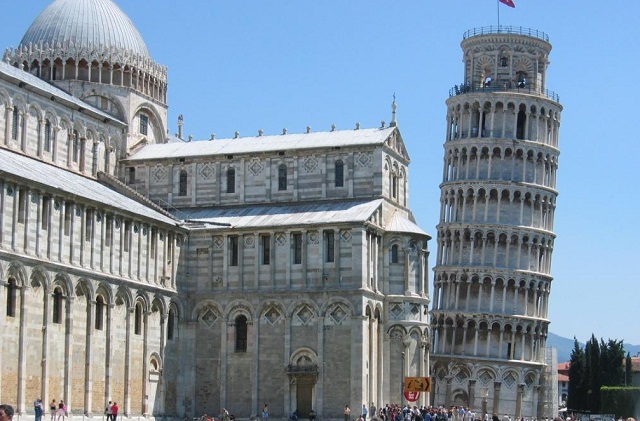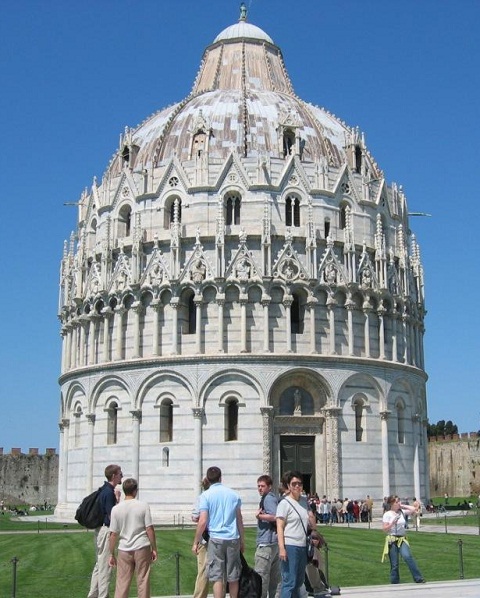There's more to Pisa than just a leaning bell tower
Pisa, Italy
“From the Central train station, take Via Gramschi, then the Corso...”
These were the quite succinct instructions our dependable guide book told us, so my husband Alex and I took an hour’s train ride from Florence, going west towards the Ligurian Sea. We wanted to visit Pisa that day – yes, the city of the leaning tower fame, although our readings showed that Pisa had so much more to offer. Armed with a clear map, Alex and I took the routes mentioned and within 20 minutes of walking leisurely, we crossed the River Arno as it caught the morning sun.
Before long we reached Via Santa Maria, and raising our eyes we couldn’t help but gasp: a tall, white tower was indeed listing under the Tuscan sun. It was the Leaning Tower of Pisa. Alex and I stopped on our tracks and laughed aloud with joy. We stood there in awe, afraid to go forward, worried that the vision might just disappear in front of our eyes. For indeed, who could forget the photos of this tower we have seen since childhood, and the stories about how it was leaning and almost toppling over? But back then, it was in far-away Italy, a place that was seemingly out of reach.
And now we were here, slowly walking towards the Piazza dei Miracoli (Square of Miracles), a huge grassy space that contained the four important edifices: the Duomo (Cathedral), the baptistery, the leaning tower that was actually the bell tower of the cathedral, and the Campo Santo (cemetery). Old medieval walls surrounded the area, and this fortification surrounded the city. Not too many visitors were there that morning, probably because it was still early spring, and even with the sunlight the breeze was a bit chilly.
We approached the leaning tower first, and learned that it was a freestanding bell tower. Its construction started in 1173, when Pisa was at the height of its maritime sway, being the chief naval port of Rome. At that time, Pisa controlled Corsica and Sardinia, among other areas, but was in frequent battles with Genoa and Florence for supremacy. Sadly, the mouth of the River Arno started to silt up, and sea trade, an important source of income, declined. Because of lack of resources, it took around 200 years for the bell tower to be completed.
Flawed design
At the outset, the foundations of the bell tower were not stable. The soil on which it stood, moreover, was weak. During the construction of the second floor, the tower was noted to sink to one side, and work was halted to allow the soil to firm up. The final tower stood 183.27 feet at its lower side and 186.02 feet at its higher end. There were seven floors, aside from the ground floor, with Corinthian columns encircling each level.
In 1964, the tilt became more pronounced, and the tower was on the verge of collapse. A team of engineers and mathematicians met and decided to put lead counterweights on the higher side to “pull” the tower more to the center. However they decided to maintain its tilt, as this was the draw for visitors all over the world. Structural strengthening from time to time was done, including the cleaning of the exterior areas, as pollutants and the open air had brought about corrosion and blackening of the walls.
The Pisa authorities had to regulate the number of visitors that ascend the bell tower at one time to avoid abrupt shifts in weight in an all-too shifty soil. There are a total of 294 steps, and at the top are the seven large bells, one note for each major scale.
The view from the tower balustrade was exhilarating, as one could see the green swathes of grass around the piazza, and the houses looking like miniatures in a bright, sunlit diorama. Alex and I were reminded of the tale about Galileo Galilei dropping two different-sized cannonballs from the bell tower, to prove his theory that their weights had nothing to do with the rate of their descent.
Going out of the bell tower, we strolled over to the Cathedral, which was no less awe-inspiring. Colored white, with impressive colonnades around it and a huge dome, it looked solid and straight beside its tilting campanile. I was mesmerized by the gold mosaic depicting the “Christ Pantocrator” (Christ, Creator of All) occupying the area near the apse; we found time to just sit on one of the pews, the bright sunlight filtering through the windows, the quiet giving us pause in the morning’s jaunts. And what structure was that, beside the cathedral, looking like a huge barrel, with such intricate carvings on it? It turned out to be the baptistery, said to be constructed in 1152. It was a high, round structure, and had three floors after the ground floor. Outside, it had similar colonnades like those at the cathedral and bell tower, and additional gables, pinnacles and statues at the upper levels.
And what structure was that, beside the cathedral, looking like a huge barrel, with such intricate carvings on it? It turned out to be the baptistery, said to be constructed in 1152. It was a high, round structure, and had three floors after the ground floor. Outside, it had similar colonnades like those at the cathedral and bell tower, and additional gables, pinnacles and statues at the upper levels.
We also found time to look at the Campo Santo, which was a cloistered courtyard cemetery. I was very intrigued by the fact that the soil that covered it was said to be the earth that the Crusaders brought back from Golgotha.
The university area
We slowly wandered off from the Piazza dei Miracoli, away from the souvenir shops and the increasing throng of tourists. We found ourselves in the area surrounding the University of Pisa, founded in 1343 by an edict of Pope Clement VI. Renowned not only for its antiquity, it was also a famous university for Physics, Mathematics, and Engineering. The Old World feel of the place was unmistakable, with its wooden-louvered windows, light brown and orange walls, and a few clotheslines peeking from small, tight streets.
Alex pointed out a trattoria tucked into a side street of the university’s Department of Romance Literature & Section of Linguistics. It looked inviting, with its red and white checkered tablecloth, potted plants, and lively atmosphere of young people in high spirits. It was the Trattoria e Pizzeria de Matteo.
We were ushered into its second floor roof garden seating, and behind us was a group of students enjoying their meal. From their lively American-accented English, we learned that they were from California, and were celebrating their end-of-term school season. Alex chose a salsichon (sausage) whole pizza with fresh tomato sauce, while I had the roast beef with fried potatoes. After eating half, we exchanged plates as was our wont, so we could share both dishes. Accompanied by a house red, Alex and I enjoyed the meal slowly. We tarried for a while in that garden terrace, enjoying the cool, sunny atmosphere, eavesdropping on the young students seated nearby. – YA, GMA News




